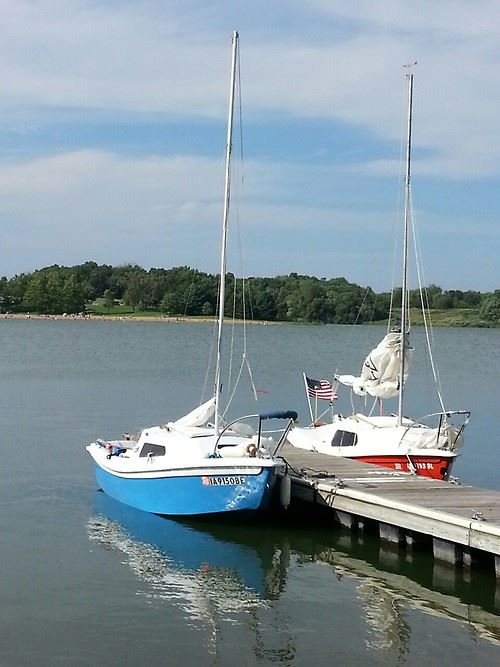December 2024
BEYOND THE HORIZON
December 2024

GRAY FLEET
Admiral William (Bull) Halsey said the kamikaze was “The only weapon I feared in the war”. Very late in the war, Captain Motoharu Okamura went to the Naval Headquarters and stated that if he could just obtain 300 planes, he could turn the tide of the war. He was close to being accurate. His plan for suicide attacks sank 47 ships and severely damaged 288. It was, by far, the greatest offensive weapon used by the Japanese.
The modern Navy has had to look back on how we responded to those attacks because they are facing a similar weapon—the anti-ship ballistic missile used by the Houthi in the Middle East. The commanding officer of the USS CARNEY reported, “An ASBM is just way faster than anything else”. Engagement to destruction is from 9 seconds to 20 seconds.
Task Force 59, an element of the 5th Fleet, is the home for unmanned naval vessels. The “swarm” concept is the foundation for drone usage because of the low costs, efficiency, and ease of control. The Sail Drone Explorer is a 36’ drone that provides a plethora of data on oceanic conditions, temperature, ships in the area, and lots of “spook” stuff. The Navy already sailed on across the Pacific.

SAIL DRONE

The Devil Ray is also an autonomous, cheap, utilitarian ship that is diamond-shaped like the Manta Ray fish. This vehicle uses buoyancy fluctuation to create electrical power for operation. It is a low power, high efficiency, deep diving capable, and virtually undetectable UUV that has an incredible duration.
The Ghost Shark was developed in Australia as an Extra-large Autonomous Vehicle (XLAUV) with assistance from the U.S. and DARPA at a cost of about $20 million. Although smaller than a normally crewed submarine, it can do anything it can do. The Pentagon is extremely tight-lipped about the ship’s mission capabilities. It was transported to America on a Globemaster C-17. Cogitate on that for a second.

Remotely Operated Vehicles (ROV) have been around for a long time and were an element for considerable sea biological and archeological studies. ROVs have been a segment of all maritime academies and allied universities. Curt Newport has been a key figure in the development and operation of ROVs which is discussed in his book READY TO DIVE. Among his work is on ROVs that found the TITANIC, recovered bodies and evidence of the Challenger disaster, and recovery of sundry aircraft that crashed into the sea.

Why are submarines called boats instead of ships? The answer is rather simple.
- Ships are considered oceanic and boats are small craft. Since subs were originally quite small, they were called boats.
- Subs were much smaller than surface vessels.
- Sub-crews liked the word “boat” because it distinguished them from surface ship crew.
- In several languages, the words for submarine tend to be more akin to boat than ship.
- Navies liked to distinguish submarines from other ships.
The USS IOWA (SSN-797) has completed her Alpha trials at sea which means that she went to sea for the first series of tests. After Electric Boat analysis is concluded and appropriate adjustments and repairs are finished, IOWA will head back to sea for the Bravo series of more intense assessments. Should everything prove acceptable, the Navy will obtain the boat from the company and commission it accordingly, probably in April.

INLAND WATERWAYS
A recent trip to La Crosse, WI shocked me viewing the Mississippi that is lower than I have seen it in the last 70 years. The sloughs were mere puddles and covered with green algae, the islands were all tall in the water, and the banks were steep. One pond that has an artesian well was virtually dried up.
The Army Corps of Engineers has attempted to stabilize the problems with constant dredging and adjusting water heights at the locks and dams without success. The main channel requires a depth of 9 feet for the barges but it has been impossible to maintain, and the narrowing channel width disallows barges passing in opposite directions. The low waters, a result of three years of drought, have stifled grain transportation because barges can only handle about half a load. Surprisingly, this issue has yet to make a significant dent in portage costs.
Memphis set a record low water level in 2022, broke that in 2023, and is now on the verge of breaking that. On the Lower Mississippi, the channel is deeper than above Chain of Rocks Dam above St. Louis. The Corps of Engineers try to keep the channel at 9 feet from St. Paul down to Dam 27 ( Chain of Rocks), below that the channel tends to be 13 feet; therefore, allowing larger tows. The low water is from 10-11’ from Cairo, IL to Greenville, MS.
Each 6” of draft equals about 106 short tons of cargo. On the Lower Mississippi with a water depth of 11.5’, 35 barge tows are common and hold about 70,735 short tons of freight or 2.5 million bushels of corn. A loss of one foot of draft forces soybean carriers to lessen loads by 200 tons.
Another problem for tows is the buoys that flank the channel indicating where they can travel are inaccurate due to the channel changes. The Coast Guard’s dredge SANGAMON is sidelined awaiting parts.
One bright side of the travel was the sight of many muskrat dens that have been absent for decades. Evidently, the trapping of them (and otters) for fur has diminished greatly. I have not seen river otters in the wild for many, many years. As a child, I read Emil Liers’ classic An Otter’s Story, which became a Walt Disney short nature film. He also wrote a BEAVER’S STORY. I left an autographed copy on the train on the way to Chicago in the 1950s but found a copy later. I also remember visiting his farm where he raised otters and beavers near Winona, MN. DNR does not allow such ventures now, but it was exhilarating watching the otters play in their pool.
The AMERICAN SERENADE, a 4-story, 56-feet wide vessel, carrying 166 guests, was moving upriver on the Mississippi near Sabula, IA, population of less than 500 (the only island town in Iowa) when it was stopped by an ancient turn-style railroad bridge that was stuck closed. After a few hours of antsy passengers, the captain beached the boat near a campground whereupon the campers opened their doors, created a potluck, entertained the guests, and even gave them the ubiquitous Iowa gift of zucchini—by the dozens.
About the time the party got going well, the RIVERBOAT TWILIGHT, carrying 106 passengers pulled along the AMERICAN SERENADE in similar straits. This simply added more folks to the party. Out came the Weber grills, the six-packs, fruits, and vegetables, as the banquet began. Small boats ferried the cruise directors to Savanah, IL to raid the liquor store. Trey Cook, general manager of the AMERICAN SERENADE, said that the people truly enjoyed the entire situation.
Eventually, the 119-year-old bridge was able to open and the boats shoved off leaving their Iowa campers as happy as the floating guests. The RIVERBOAT TWILIGHT passengers had to be bussed back to the Quad City area.

RIVERBOAT TWILIGHT

AMERICAN SERENADE
WHITE FLEET
Princess Cruise Lines is offering a 131-day voyage, The Circle of the Pacific, for 2026 that includes stops in 19 countries and 60 cities such as Hawaii, French Polynesia, Fiji, New Zealand, Australia, Bangkok, Alaska, and the U.S. West Coast. The package includes EZ air, Wi-Fi, beverages, meals, and First-Class suites with balconies.
Miami remains the center of American cruisers hosting over 8.2 million passengers this year already topping the record of 7.2 million in 2023. Companies are already scheduling new ships for the port including EXPLORA II, RESILIENT LADY, WORLD AMERICA, NORWEGIAN AQUA, BRILLIANT LADY, and OCEANIC ALLURE.

Port of Miami
The outlook for cruising seems excellent. Companies are building 67 new ships to add 179,000 new berths. The new ship’s average berths are at 2,548 and cost a mean of $845 million. When completed, the net worth of the new fleet will be $57 billion. Norwegian Cruise Lines is adding 12 new vessels, Royal Caribbean has ordered 7 cruisers, as is MSC, while Carnival is looking at 6.
SMALL BOATS
The e-zine SMALL CRAFT ADVISOR compared several small sailboats starting with the Wayfarer, a 15’8” monohull with a beam of 6’ and a draft of 3’8” with the centerboard down. It displaces about 372 lbs. as designed by Ian Proctor

WAYFARER
Bongo, is a lift keel boat of 15’6” in length and 6.5’ in width, displaces 415 lbs. but has 100 pounds of ballast. Like many small sailboats, Bongo was built in Canada.

BONGO 15
In a lengthy debate of the best of the best, a couple of sailors spewed forth the merits of Beneteau vs. Jeanneau. The latter has a Cape Breton 15 that is 13.45’ of waterline and a sail area of 107ft2 . She has a ballast of 298 pounds and needs 1’ of water to sail.

Cape Breton
Beyond the Horizon
ENVIRONMENT
The GOP is wasting no time in their assault on the Biden Administration’s actions on the Waters of the U.S. (WOTUS) which they accused the lame-duck President of disregarding the Supreme Court’s ruling on the definition of waters under control by the Federal Government. The Court ruled that the Clean Water Act failed to appropriately designate said waters and allowed the EPA and Army Corps of Engineers to make the delineations. The Court was extraordinarily nit-picking in supporting the Sackett case that said words like “near” or “by” were not specific enough for the EPA to deny Mr. Sackett from building land on swampy land on his property.
The impact of this case is far-reaching in that for the last 250 years, governmental agencies have been allowed to define rules and regulations from the Congressionally passed laws. The Sackett case opens Pandora’s Box of People challenging the meaning of words in courts.
The Blanding’s Turtle is an endangered species requiring clear shallow water to maintain its life for 80 to 90 years. The reason for the loss of this turtle is the loss of habitat. The Iowa DNR, concerned about road construction that destroys their habitat or their deaths trying to cross highways, recently built a culvert under one treacherous highway and added screens to prevent the turtles from going up banks to get from one pond to another. Surprisingly, the turtles figured this out quickly and used the tunnel to go underneath the road instead of trying to cross it.




PLEAD
Please consider buying the book The World’s Worst Sailor from Barnes and Noble or Amazon. I need to show some income to the IRS!

